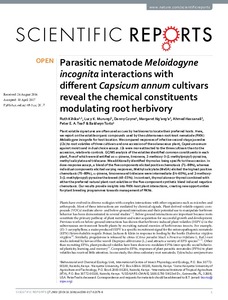| dc.contributor.author | Kihika, R. |
| dc.contributor.author | Murungi, L.K. |
| dc.contributor.author | Coyne, D.L. |
| dc.contributor.author | Ng'ang'a, M. |
| dc.contributor.author | Hassanali, A. |
| dc.contributor.author | Teal, P.E.A. |
| dc.contributor.author | Torto, B. |
| dc.date.accessioned | 2019-12-04T11:08:41Z |
| dc.date.available | 2019-12-04T11:08:41Z |
| dc.date.issued | 2017 |
| dc.identifier.citation | Kihika, R., Murungi, L.K., Coyne, D., Hassanali, A., Teal, P.E. & Torto, B. (2017). Parasitic nematode Meloidogyne incognita interactions with different Capsicum annum cultivars reveal the chemical constituents modulating root herbivory. Scientific Reports, 7(1), 2903. |
| dc.identifier.issn | 2045-2322 |
| dc.identifier.uri | https://hdl.handle.net/20.500.12478/1889 |
| dc.description | Open Access Journal; Published online: 06 June 2017 |
| dc.description.abstract | Plant volatile signatures are often used as cues by herbivores to locate their preferred hosts. Here, we report on the volatile organic compounds used by the subterranean root-knot nematode (RKN) Meloidogyne incognita for host location. We compared responses of infective second stage juveniles (J2s) to root volatiles of three cultivars and one accession of the solanaceous plant, Capsicum annum against moist sand in dual choice assays. J2s were more attracted to the three cultivars than to the accession, relative to controls. GC/MS analysis of the volatiles identified common constituents in each plant, five of which were identified as α-pinene, limonene, 2-methoxy-3-(1-methylpropyl)-pyrazine, methyl salicylate and tridecane. We additionally identified thymol as being specific to the accession. In dose-response assays, a blend of the five components elicited positive chemotaxis (71–88%), whereas individual components elicited varying responses; Methyl salicylate (MeSA) elicited the highest positive chemotaxis (70–80%), α-pinene, limonene and tridecane were intermediate (54–60%), and 2-methoxy- 3-(1-methylpropyl)-pyrazine the lowest (49–55%). In contrast, thymol alone or thymol combined with either the preferred natural plant root volatiles or the five-component synthetic blend induced negative chemotaxis. Our results provide insights into RKN-host plant interactions, creating new opportunities for plant breeding programmes towards management of RKNs. |
| dc.description.sponsorship | United States Department of Agriculture |
| dc.description.sponsorship | Department for International Development, United Kingdom |
| dc.description.sponsorship | Swedish International Development Cooperation Agency |
| dc.description.sponsorship | Swiss Agency for Development and Cooperation |
| dc.description.sponsorship | Government of Kenya |
| dc.format.extent | 1-10 |
| dc.language.iso | en |
| dc.subject | Nematode |
| dc.subject | Meloidogyne Incognita |
| dc.subject | Limonene |
| dc.subject | Root-Knot Nematode |
| dc.subject | Cultivars |
| dc.subject | Capsicum Annum |
| dc.subject | Root Herbivory |
| dc.subject | Root Volatiles |
| dc.subject | Plant Hosts |
| dc.title | Parasitic nematode Meloidogyne incognita interactions with different Capsicum annum cultivars reveal the chemical constituents modulating root herbivory |
| dc.type | Journal Article |
| dc.description.version | Peer Review |
| cg.contributor.affiliation | International Centre of Insect Physiology and Ecology |
| cg.contributor.affiliation | Jomo Kenyatta University of Agriculture and Technology |
| cg.contributor.affiliation | International Institute of Tropical Agriculture |
| cg.contributor.affiliation | Kenyatta University |
| cg.contributor.affiliation | United States Department of Agriculture |
| cg.isijournal | ISI Journal |
| cg.authorship.types | CGIAR and developing country institute |
| cg.iitasubject | Pests Of Plants |
| cg.iitasubject | Plant Diseases |
| cg.iitasubject | Plant Ecology |
| cg.journal | Scientific Reports |
| cg.howpublished | Formally Published |
| cg.accessibilitystatus | Open Access |
| local.dspaceid | 83909 |
| cg.targetaudience | Scientists |
| cg.identifier.doi | http://dx.doi.org/10.1038/s41598-017-02379-8 |

